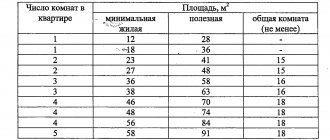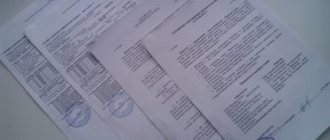Form
To draw up such an act there is no need to use a unified form. The document is drawn up in a free style. The main thing you need to pay attention to here is the indication of all important information. This is a detailed description of the apartment and the parties who are parties to the transaction. As a rule, the parties choose the most suitable form in advance by mutual agreement.
When and why do you need an apartment inspection report?
Using the deed, the parties document the condition of the property. Conventionally, the inspection report can be divided into two types:
- Required . In this case, there is no way to do without an inspection. As a rule, such situations arise during investigations, investigative or judicial audits.
- Optional . When citizens or organizations transfer an apartment from hand to hand, for example, when selling, renting or donating, drawing up a deed is desirable. But it cannot be called mandatory, because the law allows you to do without this document.
Although practice shows that recently even individuals are trying to properly prepare such a document. After all, it is this act that will be considered first if any disagreements arise between the parties. For example, if we are talking about selling an apartment, its inspection is in the interests of all interested parties:
- The seller of the apartment needs an inspection report so that he has documentary evidence of this fact. Also, taking into account the collected acts, the seller may decide to change the terms of sale. If the buyer agrees to sign the inspection report, this will indicate that he is completely satisfied with the condition of the home. Accordingly, if after the transaction the buyer wishes to make any claims, this act will be a weighty argument in favor of the seller.
- Realtor, if the seller resorted to his services. Based on this document, he reports to the seller, since the time and date of the inspection must be indicated here. Information about the buyer is also noted. With the help of this act, the realtor will be able to prove that he was the one who found the buyers.
- The buyer practically does not need an inspection certificate. Although you may encounter a situation where law enforcement agencies have questions. For example, if this apartment was robbed, the buyer will have documentary evidence of the reason why he was here.
- The tenant will need this document when he returns the apartment to the owner. The act will confirm that the technical condition of the premises has not changed.
- To the landlord when he rents out the property. After a certain period of time, he will be able to check whether the condition of the apartment has worsened. If it has changed for the worse, the owner may demand compensation from the tenant for damages.
If you are flooded
Let's now look at a specific situation. Suppose we are talking about such a nuisance as flooding of your apartment by your neighbors. How to proceed in this case? It is necessary to inspect the scene of the incident by a representative of the management company, based on the results of which an apartment inspection report must be drawn up, the sample of which corresponds to the one discussed above.
But first, let’s clarify in what order you should act in the event of such a nuisance. So, your apartment is flooded. First of all, you should inform the housing office or REU. If you don’t have it at hand, your phone number can be found in your housing and communal services receipt, in a directory, or on the Internet.
Be sure to notify those who you believe are the culprits. In this example, the neighbors above act as such. It is highly advisable to document the damage in a photo.
Premises inspection procedure
There are no regulated actions regarding apartment inspection.
Usually this procedure is individual for each case. Naturally, one person cannot conduct an inspection. For this purpose, a special commission is assembled, which includes representatives of all interested parties. Once inside the premises, the commission checks its technical condition, communication networks, and electrical equipment. In addition, special attention is paid to fire safety, which must be observed in this room. Under certain circumstances, environmental safety is also of great importance. Here the cleanliness of the apartment is checked, the absence of fungus on the walls and various parasites.
( Video : “Act of acceptance and transfer of apartment”)
The inspection commission inspects room by room, recording any comments using the appropriate report. If there are no comments, and the general condition of the apartment is satisfactory, this should be written about in the document.
Rules for drawing up an act
As you might guess, one person cannot conduct a home inspection. Indeed, in such a situation there is a high probability of making mistakes. The inspection commission must consist of at least two specialists. Typically, this procedure is entrusted to representatives of government departments and supervisory authorities. The legislation does not prohibit the involvement of additional experts in this process. These could be technicians, electricians, engineers. Thanks to this, we can say that the inspection of the premises and the inspectors’ conclusions will be as objective as possible.
You can enter information into a document on a computer or by hand. Often an apartment inspection is carried out so that the commission can determine what damage has been caused to the property. This fact should be stated in the act. In addition to this, it is necessary to note the reason why this damage was caused. If the alleged culprits are known, information about them should also be displayed in the document.
There are situations when some additional annexes are drawn up to the act. If there are any, this should be mentioned in the act itself. For example, if the inspection of the apartment was carried out using a camera, the photographs become an appendix to the report.
Requirements for drawing up an act
This document is prepared upon receipt:
- special commission, competent officials, housing office specialists;
- third parties, perpetrators of damage, victims;
- a pair of witnesses, usually neighbors.
First of all, specialists carry out mandatory measurements, carefully inspect the condition of the apartment, the integrity of finishing materials, furnishings, and household appliances.
At the end of the act, all participants sign (the owner of the premises, experts and witnesses, if necessary), which indicates its authenticity, or write reasonable objections to the document. This act can be drawn up without the other party, by attaching supporting photographs, videos, and confirmation from neighbors. Photos and videos may be needed in court as evidence.
This is important: the amount of damage is determined and confirmed exclusively by authorized experts.
Afterwards it is transferred to the other party for review and signing if they agree with the facts. It would be useful to have the residential premises inspection report certified by the independent opinion of citizens. The results of the inspection of the premises will be useful if the case is referred to the court to make a decision on providing more comfortable living conditions and compensation for damage.
General requirements for the content of the apartment inspection report in 2020
The deed is usually drawn up in the form of a descriptive document.
Although, for greater convenience, some format the document in table form. This is especially convenient when a large amount of information is entered into the act. As for the volume, it all depends on the complexity of the apartment. The larger it is, the more information will be available during inspection. The scope of the act is also influenced by the goals pursued by this inspection. The larger they are, the broader the document becomes. Important information that must be contained in the document includes information about the real estate that was subject to inspection. The responsible persons who worked directly at the site are also indicated here. Naturally, the commission must draw conclusions. If there are any comments, they are recorded in the act. If there are none, it should be written that there are no comments.
The document must have several copies. Each interested party must receive one copy. All of them have the same legal force; accordingly, autographs of representatives of each party must be affixed here. If an organization that uses a seal in its activities takes part in a transaction, it puts the stamp on the document. It must be remembered that a correctly drawn up act will become powerful evidence in court proceedings.
Instructions for filling out the act
Despite the fact that the document is drawn up in free form, there are general rules for office work. Usually there are no difficulties with filling out the act. The document is filled out step by step:
- You need to start by filling out the “cap”. The name of the document, city and date of compilation are indicated here.
- The composition of the inspection team is indicated. This is not only the name of each specialist. It is necessary to indicate what organization he represents and what position he holds.
- The fact of inspection of the premises is confirmed below. You must indicate the exact address where it is located. If the apartment is on the balance sheet of some company, this should also be mentioned.
- Next, members of the review team must draw conclusions. If no defects are found, it is necessary to indicate that the condition of the premises is satisfactory.
- It would be useful to point out that there are no comments on the electrical equipment and the general condition of the apartment.
- The final stage of filling out the document is affixing autographs of all responsible persons. Moreover, the signatures must have a transcript.
It is worth noting that this is only an approximate example of filling out the document. At the discretion of the responsible persons, you can specify additional items in which more detailed information will be displayed. For example, you can imagine a situation where members of the inspection team discovered any problems or malfunctions. In such a situation, they must be written down in great detail. Here you need to understand that even the smallest complaints must be described. After all, they are the ones who can cause disagreements between the parties. For example, when renting out an apartment, the commission will not take into account torn linoleum. If the tenant does not notice such an oversight, it will be considered that he received the apartment in perfect condition. Upon its return, the owner may demand compensation for damage to which, in fact, the tenant has nothing to do. Therefore, even minor details must be displayed in the document.
Preliminary act of accepting the transfer of an apartment in a new building
Law FZ-214 gives us the right, if deficiencies are detected, not to sign the Transfer and Acceptance Certificate . But without it, registration of ownership will not begin, and this is also not a quick process. Therefore, in order not to waste time, it is better to record in writing all the detected deficiencies in the Inspection Sheet , sign the Act , and hand it over to the Developer to send to Rosreestr for registration. This does not relieve the Developer of the obligation to eliminate the noted deficiencies.
Sample of a preliminary apartment acceptance certificate indicating a list of deficiencies
Apartments in modern new buildings, to be honest, are almost always delivered with defects and imperfections . This is a fact confirmed by practice. The only question is how serious these shortcomings are and how many there are. According to estimates of specialists involved in the acceptance of apartments in Moscow, for example, the amount of costs Buyers will have to independently correct defects in new apartments ranges from 50 to 150 thousand rubles. (data for 2020).
If the seller refuses for any reason to sign the acceptance certificate for the apartment, the purchase must be terminated. An unsigned form does not complete the financial transaction and makes it illegal. Without it, problems may arise with further registration of property rights, since many branches of Rosreestr require this kind of documentation.
The final stage of the sale is the preparation of an apartment transfer certificate for the property. The terms of this transfer of rights must be agreed upon in advance in the contract and completed upon signing the transfer form.
Blots and corrections in the inventory are unacceptable.
Features of receiving common property
In part one of the law on DDU in article 7 and in part 5 of the same law in article 8 it is stated that acceptance of an apartment from a developer may involve drawing up documents stating that the property was built in violation of:
- agreements with the shareholder;
- SNiPov;
- current regulations;
- other requirements that are mandatory to comply with.
Based on the rights of the participants of the DDU provided for in the legislation, the apartment inspection report is not the only document that needs to be given attention, since it is also necessary to check the presence and operability of the garbage chute and street lighting, the functioning of elevators, etc. First of all, the presence of objects provided for in the relevant regulations is checked or agreement: playground, parking spaces, fencing the territory, etc.
If we talk about what to pay attention to when accepting an apartment, it should be noted that partial transfer, with the obligation to eliminate the detected defects in the future, is unacceptable. If there are inconsistencies or part of the property is not ready for delivery, is missing, etc., then this should be reflected in the report of defects drawn up based on the results of the inspection (it can also be called a report of construction defects or a preliminary report). If the acceptance of the apartment from the developer is completed by signing a regular acceptance certificate, then the residents will have to fix the detected problems, since the presence of defects is not displayed anywhere.
In fact, the DDU covers not only the apartment indicated in it, but also the common property of the building. However, lawyers do not recommend taking the developer’s word for it that the management company is responsible for the acceptance of common property. Yes, in practice this usually happens, but this is due to the fact that citizens do not understand the existing legislation well and do not carefully read the terms of the contracts concluded, otherwise they could demand a penalty for delaying the transfer of the house due to discovered deficiencies.
The parties to the agreement who are about to accept the transfer of an apartment often simply do not want to burden themselves with the problems that arise during the transfer of common property, and some believe that the owner is the management organization. However, this point of view is wrong. Neither the state nor anyone else is the owner of the common property, since it is owned by the buyers of the property and they are the ones responsible for its condition. Even the fact that city authorities periodically allocate some amounts in the form of subsidies does not mean that this responsibility can be shifted to someone else.
We should not forget that today a capitalist system has been established in our state, and citizens accustomed to socialism have to change their ideas about relations to property. Those who have not done this sometimes have to pay much more for living in a new building than for an apartment located in the old building. And this is explained precisely by the fact that property owners were poorly informed about how to accept an apartment from a developer, and are now forced to eliminate deficiencies not indicated in the defect sheet at their own expense. Hence the significant size of housing bills. This can be avoided if the residents of the house unite to protect their rights and can ensure that the developer delivers the new building in proper condition. Lawyers recommend hiring independent specialists, whose expert opinion can be used to file a claim with a list of identified deficiencies. The technical inspection compiled by them should form the basis of a list of construction defects that is sent to the developer. In this case, the requirement to pay for the services of independent experts can also be included in this claim or statement of claim to the court. If residents manage to defend their position, the size of their bills will be significantly reduced, and the money will be allocated for additional improvements. But this area of spending is not the topic of this article.
What should the apartment inspection report be like?
(place of document preparation) (date)
The Developer (name of the organization), represented by (name and position of the manager), on the one hand, and the Shareholder (information about the buyer: full name, passport details, registration address, etc.), referred to in this document as the Parties, as this was indicated in agreement No.____, we compiled this list of claims regarding the condition of the inspected premises.
| Apartment No. | Floor on which the apartment is located | Number of rooms | Apartment no. on site | Area, m2 | Total area (taking into account applied reduction factors) m2 |
At the apartment located at (address of the house), as well as at the common property. The list and required condition of which were provided in the design documentation for the house. During a joint inspection by the Parties to this agreement, a number of shortcomings were discovered (the given list was compiled using the example of one of the new buildings, therefore, when drawing up a claim, it is necessary to focus on the individual characteristics of the object):
- There is no asphalt on the driveways;
- There is no wheelchair ramp;
- There is no asphalt in the local area;
- There is no playground for children;
- Access lighting is not connected;
- The elevators did not start working;
- The premises located on the ____ floor, intended for shared use by residents, do not have fire alarms and fire panels equipped in accordance with the standards;
- On the ____ floor there is no apartment meter on the landing, and the electrical wiring to the apartment electrical panel has not been completed;
- There is no low-current wiring to the panel on the ____ floor;
- On the ____ floor, the doors leading to common areas for residents are not equipped with the glazing required by the design;
- The basement floor is flooded;
- Some sewer pipes are missing connections, which leads to leaks in the basement of the house;
- There is no glazing of the balcony provided for by the conditions of the DDU;
- The quality of the glazing in the window openings does not meet the standards - the structures are unevenly installed and poorly secured, there are cracks;
- Kitchen windows are not equipped with the necessary fittings;
- The window glass in the room has a crack;
- The entrance door to the loggia was installed incorrectly, which led to misalignment, preventing normal opening and closing;
- There is no hot or cold water supply in the inspected apartment;
- In-house water metering devices (if necessary, indicate cold or hot) are not installed;
- The floor near the ventilation shaft has through holes;
- The sewer riser in the apartment has a crack;
- The installation level of the connector in the sewer riser, intended for the outflow of wastewater, is only 4 centimeters above the floor. This leads to the impossibility of competently performing the screed;
- The door frame leading to the apartment is installed askew, the door lock does not work, and the door fittings are missing;
- The fire exit does not have a hatch installed.
(Note: it is desirable that, along with the detected deficiencies, the document contains references to which specific clauses of the contract with the developer. Project documentation, relevant SNiPs, etc. were violated. However, if the developer signed this defective statement without these references, then it is considered that he agrees with the existing comments. If the developer does not sign this sheet, it is necessary to send it in the form of a valuable letter with a list of the attachments. And here it is required to indicate which specific standards are violated by the identified deficiencies.)
The document was drawn up jointly by the Parties to the agreement in accordance with paragraph 5 of Article 8 of the law on DDU.
The developer, after eliminating the shortcomings listed in this act, is obliged to notify the Participant in writing that the property is at the stage of readiness for acceptance and transfer.
Developer details:
Information about the DDU Participant:
_____________________ (information should copy
_____________________ data set out in the DDU)
_____________________ (signature) / F. AND ABOUT./
It is also advisable to indicate in the defect sheet the time frame within which the developer is obliged to eliminate the detected defects. In this sample there is no such line, since the claims work was carried out with the developer, who does not comply with the deadlines for putting the facility into operation. It should also be taken into account that the DDU clearly regulates the time frame within which an apartment in a new building must be inspected and handed over to the shareholder. Accordingly, for non-compliance with them, a penalty must be paid, the accrual of which is not suspended for the period during which it is necessary to eliminate the deficiencies. Thus, the developer himself is interested in doing this as soon as possible, so as not to subsequently pay large amounts of compensation to residents. If representatives of the developer’s organization refuse to sign the preliminary act, then this document should be sent to them in the form of a letter with an inventory.
If you are looking for information on how to accept an apartment, you should remember that the persons signing this document from the developer must have the right to do so. Because if they do not have the appropriate powers, the act loses legal force. Another important nuance regarding the claims sheet is that it is often signed by a representative of the management company. However, this formulation of the question is incorrect, since the DDU clearly indicates two parties - the Developer and the Participant (buyer), therefore, only they have the right to sign such documents. If another organization is listed on the inspection sheet, then you need to inquire about the authority of such persons. In the absence of the necessary authority, it is necessary to duplicate the defective statement with a claim addressed to the developer. And the act of acceptance of the transfer of the apartment itself will be signed by the latter’s authorized employees.
What to do if deficiencies are discovered regarding the condition of the apartment or common property
One of the main questions regarding how to accept an apartment in a new building concerns the problem of the inconsistency of the object provided for inspection with the existing conditions of the building regulations, construction standards and other requirements listed in Article 7 of Law 214-FZ.
Lawyers working in this area of law recommend going to the apartment with an expert who has the right to estimate the amount it will cost to eliminate the problems found and draw up his conclusions in the form of a conclusion. This document has official force and can be used as evidence of your position in court.
Article 7 of the law on DDU regulates the rights of the buyer when defects in the apartment are discovered. In accordance with it, the shareholder may demand:
- Eliminate defects. According to the law, the period for eliminating deficiencies free of charge must be agreed upon by the parties, but most often the shareholder is verbally informed that as soon as the problems are eliminated, a call will follow. The buyer has the right to demand compliance with the law. Each participant in the DDU decides for himself whether to believe or not promises that are not confirmed in writing. As a rule, if the house was built on time and the defects are minor. Then they will be eliminated quickly, but if the construction is delayed, then perhaps the work to solve the problem of deficiencies will not be quick either;
- Reduce the cost of the apartment. Most often, the buyer is able to achieve the exercise of this right only through the courts. Developers extremely rarely agree to reduce the cost of living space and return part of the funds. Alternatively, you can try to resolve the problem by offsetting mutual demands. This becomes possible if, after measurements, the area of the apartment has increased. Since the buyer is obligated to pay for the excess square footage, the developer may waive his claims in exchange for waiving the reduction in value;
- Compensation for expenses to be incurred by the buyer when eliminating defects . First of all, the buyer must invite an expert who will document the existing shortcomings. Then they invite a construction company to fix them, and only after that it will be possible to file a claim in court, providing all the receipts for the repairs.
If significant violations of regulations and standards are detected, as well as if the shortcomings are not eliminated, the DDU participant receives the right:
- cancel the contract,
- demand a refund of the money paid,
- demand payment of penalties for the use of funds for the entire period from the moment of their deposit.
However, it must be remembered that this process involves filing a corresponding claim in court. Moreover, even with a positive verdict, it is not always possible to obtain a refund of the money paid. You can read more about this here.
What you need to know about accepting an apartment if no deficiencies are found
If the shareholder, after inspection, agrees to accept the apartment, then you need to make sure that the date of signing the deed is present in the document and corresponds to reality. This requirement is especially relevant if the delivery of the house occurs later than planned. The absence of a date risks the fact that after signing, the developer can put any number he needs in the empty column. And this, in turn, can lead to a significant loss of funds for the buyer. He may lose the right to demand a penalty for the delay in putting the house into operation, or he may be required to pay utility bills for the entire period from the date of acceptance of the house. There is one more nuance - before signing the act, the participant of the DDU may be required to make advance payments for utilities. Such a claim is illegal; payment of this amount can only be made on a voluntary basis. However, in case of refusal, the developer usually does not sign the deed and does not give the keys to the buyer. As a result, the shareholder has to prove his case in court.
All issues related to delays in commissioning are regulated by existing legislation, but it does not indicate what to do if the act contains a phrase about the absence of material claims on the part of the buyer.
The shareholder has the right to demand the removal of such clauses from the document, but if the keys to the apartment are needed immediately, and the developer refuses to redo the documents, then such a deed can be signed.
Residential inspection report sample form
Free consultation by phone Contents The premises inspection report is a document reflecting the inspection of the building. Such a document can be drawn up by a commission created from 2 or more people. The act is drawn up when selling or exchanging buildings, as well as in case of emergency disasters that befell housing construction. When inspecting the building, the commission enters the identified comments into a special act.
Such a commission has the right to inspect residential and non-residential buildings, apartments, rooms or an entire multi-storey building, etc. When drawing up an inspection report for a building, members of the commission can draw up an acceptance certificate, a defective protocol or a protocol on write-off of property. When inspecting a building, the commission fills out a report showing comments at the site and detailing the elements. What data is entered in the act? Before writing the act, the date and time of the survey is recorded in the document,
If you signed an apartment inspection report with a realtor but purchased without an agency
quote the entire message tanya81 Active Forum participant November 20, 2012 566 February 7, 2013, Thu, 2:04 pm If a person found an apartment on his own, then what’s the point of contacting the Academy of Sciences? To formalize a transaction, you can simply contact the Academy of Sciences to formalize the transaction; you do not need to conclude an agreement, just pay for registration.
It is not necessary by law, but in practice it is often required); - notarized consent of the second spouse (in the cases described in Section 6); - if the transaction is completed with the participation of a bank (for example, in the case of a mortgage, you will also need a technical passport, a BTI certificate, an assessment of the value of real estate); — marriage contract (if one was concluded); — a correctly executed notice of the upcoming sale or a notarized refusal of the remaining participants in the common shared ownership of the right of pre-emption to purchase a share (when purchasing a share); — permission from the guardianship and trusteeship authority to alienate property if the owner is a minor or incompetent; - a court decision that has entered into legal force recognizing a citizen as missing, incompetent, or partially capable; - special documents if legal entities or foreigners are involved in the transaction, etc.
How to draw up an inspection report for residential premises
In this case, in addition to the indicated persons, the act must be signed by two disinterested witnesses who were present during the inspection. If assessing the damage is difficult, then an independent expert is invited to draw up a document.
The apartment inspection report is drawn up by the commission and signed by the inspection participants and interested parties. The form of the act may vary depending on the specific situation. Let's consider in what cases an inspection report is required and how to draw it up.
Inspection of the apartment before purchase
- if he is a parent, then for the development and play of children, a playground near the house, a kindergarten or a school is necessary;
- If the buyer has a car, parking close to his place of residence will be a huge plus.
- Title deeds - allow you to find out exactly how the apartment passed to the real owner.
- Confirming rights - will allow you to determine the type of object of right, the type of right - common or shared ownership, as well as find out the cadastral number of the residential premises.
- Technical passport (apartment plan with a description of the premises, materials from which the building is constructed).
- The cadastral passport contains information about the date of construction of the house, the cadastral value of the residential premises, and the main characteristics of the property.
- An extract from the house register or apartment card will allow you to find out the information and number of persons who are registered in the apartment at the moment.
- An extract from the Unified State Register of Rights (USRR) must contain current data about the owner and property, the presence of encumbrances.










